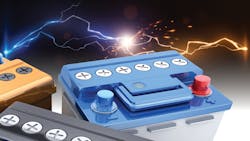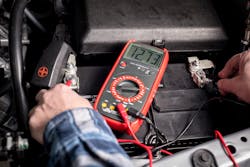How to prolong and maintain modern CV batteries
It’s fitting that when commercial vehicle battery manufacturers discuss their latest products, there are both positive and negative sides to the story.
On the positive side, development efforts have led to more advanced, longer-lasting batteries. At the same time, the need for increased power from on-board vehicle electronic systems and driver amenities negate some of these power-ups. Fleets can tip the electric power balance in their favor by specifying the right products and employing effective maintenance practices.
“Innovations in batteries have been accelerating in the past decade and commercial vehicle fleets have been able to take advantage of the resulting increases in capacity, reliability, and longevity that they have provided,” said Jeremy Cordray, director of technical sales, transportation markets at EnerSys, maker of Odyssey batteries.
“However, electronics on commercial vehicles have also accelerated at a greater pace and therefore the energy storage-to-demand gap has increased,” Cordray added. “That challenge has led to a focus on advancements like Thin Plate Pure Lead (TPPL) battery technology to solve current demands.”
Enhancing TPPL with carbon, for example, increases battery life by 50% over conventional TPPL, Enersys found.
John Bania, managing director, heavy-duty market, at Clarios, which offers its new line of heavy-duty Freedom Batteries, also pointed to rising electrical demands in today’s trucks as powertrains become more advanced and hotel applications become more common. As a result, AGM (Absorbent Glass Mat) battery technology has improved to support these trends.
“The next generation of AGM products provide sustainable charge acceptance and consistent deeper cycling performance over time without compromising the benefits of today’s technology,” Bania stated. “They also do that at a favorable price-value ratio.”
In Will You Make it, Break It, or Break It Down? Making the Right Battery Choice for Your Fleet, a white paper from East Penn Manufacturing, Jeff Coleman, vice president of sales for original equipment, spelled out the different battery types found in most Classes 6-8 trucks. For many applications, he noted, standard flooded batteries can still provide dependable service, but it’s important to remember that what might have been the right battery type in the past may not be right for modern vehicles.
Where vehicle systems are more demanding on the truck’s batteries, AGM is the right place to start, Coleman added. This battery design helps prevent damage from vibration and extended cycling. A system of valve regulation also promotes long life and enables maintenance-free performance.
Prolonging battery life
Since 2011, trucks have received enhancements for better aerodynamics for fuel economy, but not without a cost. The positioning of heat-generating items closer to the battery box have caused much higher temperatures, some even hot enough to fry an egg, Coleman related. Heat is detrimental to batteries, he added, and they experience so much heat in warmer months that they lose the necessary capacity and resiliency to have the power needed to operate in colder temperatures.
Battery designs with some type of thermal or heat protection are best equipped to maximize the truck’s electrical system performance in the hot or cold, Coleman stated. East Penn, for example, developed its Fahrenheit AGM batteries with Thermal Shielding Technology to provide protection against higher temperatures and extend cycle life.
It is clear that selecting the right battery can improve uptime and performance in commercial vehicles. And according to Cordray, proper selection is the most impactful best practice a fleet can adopt for prolonging battery service life.
“When a battery’s technology is below the demand of the application in a commercial vehicle, the gap between the technology and the demand of the application widens,” he stated.
“Battery selection based on multiple criteria developed from the application will allow fleets to select a battery that fits their vehicles,” Cordray added. “The best opportunity for every fleet to prevent battery problems is to understand the capability of their current batteries in their application, so they can anticipate when problems will arise and address them before they cause downtime.”
Bania offered that Clarios has programs in place with several customers who return batteries to its labs for testing and teardowns for root cause failure analysis. Data from the teardowns are then analyzed and used for improved battery selection, and to make manufacturing process improvements.
Proactively maintaining batteries
With effective spec’ing and proven alternative power technologies, fleets should explore other ways to extend battery life. “Fleets don’t throw away tires just because they’re low on air,” said Larry Rambeaux, sales application engineer at Purkeys. “The same rule should apply to batteries; they should not just get removed due to discharge. If you throw away batteries simply because they are dead, you will never realize their acceptable lifespan in your operation.”
Rambeaux suggested that to prolong older batteries’ lifespans, downcycle them to yard jockeys or other equipment where they can be monitored more easily. “That can make great sense for fleets,” he said, because these batteries “are still good, but not what you would put back in a truck that you won’t see again very often.”
Whatever the battery’s age, technicians should perform frequent battery checkups.
“What’s most important is that batteries must be properly serviced along with the entire vehicle’s electrical system,” Rambeaux said. “Better batteries do not take the place of proper maintenance. Simply buying more expensive batteries usually only means having problems on Thursday instead of Wednesday.”
Rambeaux went on to note the importance of training technicians on proper procedures for using battery testing equipment. He added that new testers can store records in the cloud so managers can make sure their maintenance staff is doing the job correctly.
“There are several actions fleets can take to prolong the service life of their batteries,” Bania said. “One is properly testing and maintaining batteries at scheduled maintenance intervals. In addition, properly store batteries when they are not in use for long periods of time. It is important to ensure that the voltage does not drop below 12.4V, so we recommend putting those batteries on a maintainer.”
Clarios also recommends that fleets follow standard maintenance procedures for batteries by using testing and charging systems in their shops. Whether you’re using a handheld tester or a load tester, it is important to ensure the right setting is selected for AGM or flooded batteries, Bania also advised.
It is critical as well that you ensure that proper connections are made to the lead pad at the base of the terminals, or to the lead adaptors that connect to a threaded stud post, Bania pointed out. Improper connections can provide false readings and impact charging. And for high voltage batteries, he added, it is especially important to follow the guidelines and recommendations from the OEM as well as the battery supplier.
“As with any tool in a shop, battery testers and chargers should be evaluated for accuracy with the types of batteries that are used, and also for usability,” Cordray said. “The tools will be most effective when easy-to-understand equipment and procedures are in place that encourage the use of diagnostic test results.
“In applications where idling is not possible, deep discharges can become normalized and charging is critical to ensuring that the battery achieves the longest life possible,” Cordray added. “Charging of batteries can be specific to the manufacturer, so a review of the technical specifications from the battery manufacturer is recommended.”
About the Author

Seth Skydel
Seth Skydel, a veteran industry editor, has more than 36 years of experience in fleet management, trucking, and transportation and logistics publications. Today, in editorial and marketing roles, he writes about fleet, service, and transportation management, vehicle and information technology, and industry trends and issues.


